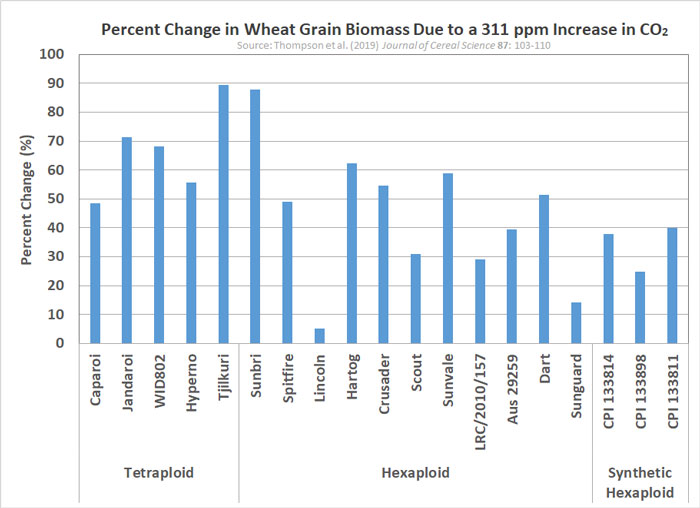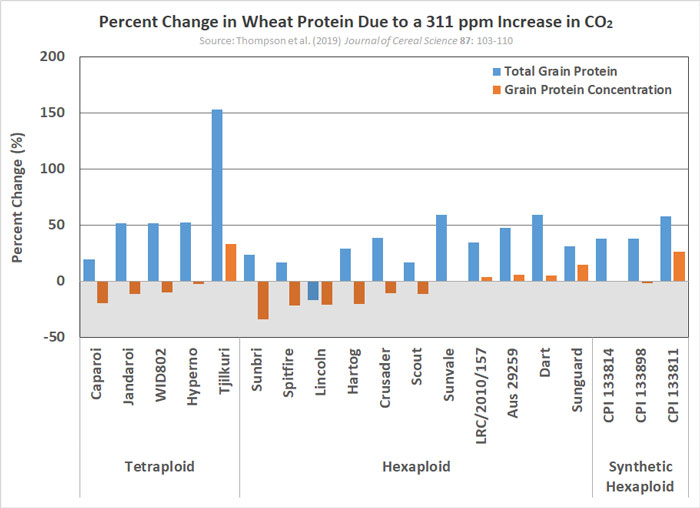| Tweet | Follow @co2science |
Paper Reviewed
Thompson, M., Gamage, D., Ratnasekera, D., Perera, A., Martin, A. and Seneweera, S. 2019. Effect of elevated carbon dioxide on plant biomass and grain protein concentration differs across bread, durum and synthetic hexaploid wheat genotypes. Journal of Cereal Science 87: 103-110.
Wheat is a key food crop grown and consumed throughout the world. In a recent study Thompson et al. (2019) examined the biomass and grain protein concentration of 19 different wheat genotypes in response to elevated levels of atmospheric carbon dioxide.
The study was conducted in an environmentally-controlled glasshouse at the University of Southern Queensland, Toowoomba, Queensland, Australia, in 2014. The 19 genotypes, consisting of five tetraploid durum wheats, eleven hexaploid bread wheats and three synthetic hexaploid wheats, were grown in pots and subjected to CO2 concentrations of either 389 (ambient) or 700 (elevated) ppm. At maturity, the authors analyzed the biomass and protein content of each genotype.
And what did those measurements reveal?
In terms of biomass, as shown in Figure 1, grain biomass gains ranging from 5 to 89 percent (average of 48%) were observed among the various genotypes in response to the 311 ppm increase in atmospheric CO2. With respect to protein, 18 of the 19 genotypes experienced an increase in total protein content and six experienced an increase in grain protein concentration (see Figure 2).
The above findings shed important light in the debate over the nutritional quality of crops under elevated CO2, where it is frequently assumed that although rising CO2 will increase crop yields, the harvested food will be less nutritious. Obviously this claim ignores the fact that there is a large fraction of genotypes (in this case nearly one-third) that do not exhibit declining protein concentrations at higher levels of CO2. In fact, one of the genotypes, Tjilkuri, witnessed a 33.1% increase!
The great CO2-induced nutrition scare will likely never occur in the agricultural industry, as it can be simply overcome by identifying plant genotypes that do not experience protein and other macro and micro nutrient declines and then growing them. Cross breeding of different genotypes with different traits would further help to enhance both the quantity and quality of crop yields for society to take the best advantage of the ongoing rise in atmospheric CO2. The truth be told, there is absolutely no compelling reason to be concerned about the future food nutritional security of the planet, unless the world goes mad and sticks its proverbial head in the sand by refusing to identify and grow those crop genotypes that will enhance both the quantity and quality of future yields.

Figure 1. Percent change in wheat grain biomass of 19 genotypes due to a 311 ppm increase in atmospheric CO2. The source of this figure is data presented in the authors' Table 2.

Figure 2. Percent change in total grain protein and grain protein concentration in 19 wheat genotypes due to a 311 ppm increase in atmospheric CO2. The source of this figure is data presented in the authors' Table 1.




